"Stick a Cowboy Hat on 'em"
25 Years of Texas Monthly Images
Fri., Jan. 23, 1998
Women With Big Hair by Danny Turner, December 1992
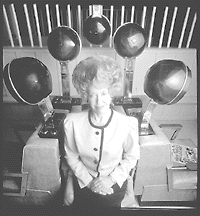 I was having lunch with photographer Danny Turner and he said, "You know, D.J., you know what I'd really love to do? I'd love to do a story on big hair. I just saw this woman at the airport with huge hair, you should really do that, that's a major Texas thing." So I took that idea to [executive vice president and editor] Greg Curtis and he liked it, so we researched it. We hired a researcher who happened to be Christina Patoski, who is Joe Nick Patoski's sister, and she's got a really good eye for things that are quirky. She loved the idea. During the process, I remembered that when I was in Lubbock going to school out there there was a Furr's Cafeteria over in the Town & Country shopping center and I used to eat there all the time because my wife's parents had a flower shop over there in that shopping center. I remembered this woman who was the tea-cart lady and in my memory she had the biggest hair. And I remembered it being kind of pink. So I told Christina she had to find that lady and she went to Furr's and there she was. And so we sent Danny up there and photographed her and I don't think she had any idea of what was going on.
I was having lunch with photographer Danny Turner and he said, "You know, D.J., you know what I'd really love to do? I'd love to do a story on big hair. I just saw this woman at the airport with huge hair, you should really do that, that's a major Texas thing." So I took that idea to [executive vice president and editor] Greg Curtis and he liked it, so we researched it. We hired a researcher who happened to be Christina Patoski, who is Joe Nick Patoski's sister, and she's got a really good eye for things that are quirky. She loved the idea. During the process, I remembered that when I was in Lubbock going to school out there there was a Furr's Cafeteria over in the Town & Country shopping center and I used to eat there all the time because my wife's parents had a flower shop over there in that shopping center. I remembered this woman who was the tea-cart lady and in my memory she had the biggest hair. And I remembered it being kind of pink. So I told Christina she had to find that lady and she went to Furr's and there she was. And so we sent Danny up there and photographed her and I don't think she had any idea of what was going on.
Sheriff Rufe Jordan by Kent Barker, Gray County, November 1984
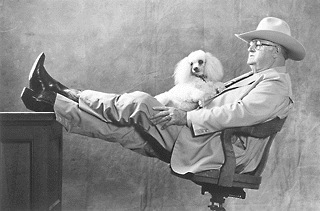
This is a posed photograph. There's a backdrop so you don't see the guy's office. What's great to me about this particular picture and a lot of the pictures that are posed is that it's posed but during the posing there's some kind of real emotion going on there that you've captured. The story behind this picture is that when Kent [Barker] showed up at this sheriff's, who was a really well-loved sheriff up in Pampa, he was sitting there like that with his legs up on the desk when Kent showed up at his office, with that little poodle up on his lap. And Kent thought, "You just can't beat that." So he set up the backdrop and then he said, "Can you put the dog up on your lap?" And he said sure, so he called the dog and the dog was so used to it he just jumped up there on his lap. It's just this great symbol of this big tough Texan, and here's this little dog. It's a great symbol of what we think we are here in Texas.
White Supremacist by Dan Winters, Vidor, December 1993
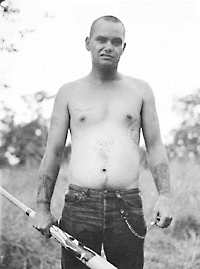 There was a parade in Vidor where the skinheads and the Ku Klux Klan were celebrating the fact that Vidor didn't have a black resident, so we sent Dan Winters, who kind of looks like a skinhead, he does, he looks like a big ol' burly skinhead. He's a great guy. He photographed a bunch of these guys who were in the parade. One thing that Mimi Swartz who wrote the story was interested in - it was a pivotal part of her story - was that she went to this cafe in Vidor, in this strip shopping center. And she went there and she had lunch and she overheard locals talking and she overheard racist conversations. For a writer, that's a very nice way to talk about a town, overhearing this stuff, and she wanted us to photograph the cafe. We went after shooting a lot of other stuff to the strip shopping center and Dan and I both drove up to it and said that it just wasn't worth shooting it because it just looked like a strip shopping center. You can't take a picture of racist conversation. You just can't do it. All it's going to look like is a little cafe in a strip shopping center. So we just didn't even take a picture.
There was a parade in Vidor where the skinheads and the Ku Klux Klan were celebrating the fact that Vidor didn't have a black resident, so we sent Dan Winters, who kind of looks like a skinhead, he does, he looks like a big ol' burly skinhead. He's a great guy. He photographed a bunch of these guys who were in the parade. One thing that Mimi Swartz who wrote the story was interested in - it was a pivotal part of her story - was that she went to this cafe in Vidor, in this strip shopping center. And she went there and she had lunch and she overheard locals talking and she overheard racist conversations. For a writer, that's a very nice way to talk about a town, overhearing this stuff, and she wanted us to photograph the cafe. We went after shooting a lot of other stuff to the strip shopping center and Dan and I both drove up to it and said that it just wasn't worth shooting it because it just looked like a strip shopping center. You can't take a picture of racist conversation. You just can't do it. All it's going to look like is a little cafe in a strip shopping center. So we just didn't even take a picture.
She didn't have him [the White supremacist] as a character in the story but he was part of that parade; she did mention the celebration. To me this is such an illustration of the hate; this gets to the heart of her story, it just does it in a visual way. So there are some things that are best left visual. The photographs speak by themselves, and if she were to describe this picture it wouldn't have been as strong. And there are some things that need to be left verbal.
The Cutler Family, by Keith Carter, Houston County, February 1988
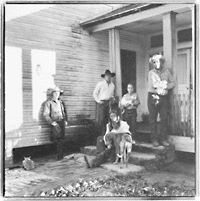 [Keith Carter] had inherited his mother's business, which was sort of like Olan Mills-type portraiture, and people would sign up and he would go and take their pictures, mostly in color. When I first started at the magazine in 1987, that summer he'd gone on a trip with his wife Pat and they traveled around Texas and they went to all these little towns, like Happy, Texas. They went to a town called Uncertain and a town called Blue. Every night they would just pop open the trunk and I think he said he had a cooler in there with gin and tonics. They would find a funny-sounding town and ride out towards the town and then they would just take personal pictures. And that's sort of the first time that I ever saw his photographs. He sent me a box of these photographs, and I remember thinking, "Who is Keith Carter?" I was pretty new. I just remember opening that box and here were these pictures, these very kind of personal pictures like these with the title of the town on there and it was the perfect Texas Monthly project and he had done it on his own. And I just remember this chill going up my back.
[Keith Carter] had inherited his mother's business, which was sort of like Olan Mills-type portraiture, and people would sign up and he would go and take their pictures, mostly in color. When I first started at the magazine in 1987, that summer he'd gone on a trip with his wife Pat and they traveled around Texas and they went to all these little towns, like Happy, Texas. They went to a town called Uncertain and a town called Blue. Every night they would just pop open the trunk and I think he said he had a cooler in there with gin and tonics. They would find a funny-sounding town and ride out towards the town and then they would just take personal pictures. And that's sort of the first time that I ever saw his photographs. He sent me a box of these photographs, and I remember thinking, "Who is Keith Carter?" I was pretty new. I just remember opening that box and here were these pictures, these very kind of personal pictures like these with the title of the town on there and it was the perfect Texas Monthly project and he had done it on his own. And I just remember this chill going up my back.
Women With Big Hair by Danny Turner, December 1992
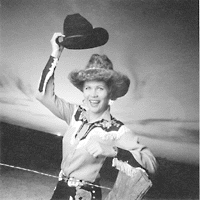 This is an actual woman. That was on the cover. She sent me a photograph of herself with a letter two years before we ever did that picture. She sent me a little snapshot, she said something like, "Dear Mr. Stout, I like to wear my hair like a cowboy hat. Will you put me on the cover of Texas Monthly?" I saved it and by the time we tried to find her two years later she'd already been divorced. She was living on a ranch somewhere down south I think. We found her. It took Christina forever to find her. She was actually living in Childress.
This is an actual woman. That was on the cover. She sent me a photograph of herself with a letter two years before we ever did that picture. She sent me a little snapshot, she said something like, "Dear Mr. Stout, I like to wear my hair like a cowboy hat. Will you put me on the cover of Texas Monthly?" I saved it and by the time we tried to find her two years later she'd already been divorced. She was living on a ranch somewhere down south I think. We found her. It took Christina forever to find her. She was actually living in Childress.
Skip Hollandsworth wrote the story that went with it. But the photographs were all done. We didn't follow any research that he had done; we didn't follow his story. We went and took the best pictures and then he wrote the story later. And he didn't write about the pictures. I love for written stories to run in a parallel fashion to photographic stories, where they cross over every now and then on the same themes. There's nothing worse than just writing about the photographs; because you see the photographs, you don't need them to be described to you. So what he wrote was an essay about how much he loved big hair.
Southwest Airlines CEO Herb Kelleher by Mark Hanauer, Dallas, April 1989
 The reason I have [Herb Kelleher, Southwest Airlines CEO] paired off with Ross Perot is that Kelleher was cooperative. Ross Perot hates to have his picture taken and the more he has his picture taken, the more he hates it but the reason is he doesn't collaborate with the photographer. If you're going to have your picture taken, you need to cooperate with the photographer, you know.
The reason I have [Herb Kelleher, Southwest Airlines CEO] paired off with Ross Perot is that Kelleher was cooperative. Ross Perot hates to have his picture taken and the more he has his picture taken, the more he hates it but the reason is he doesn't collaborate with the photographer. If you're going to have your picture taken, you need to cooperate with the photographer, you know.
Billionaire Ross Perot by Brian Smale, Dallas, December 1987
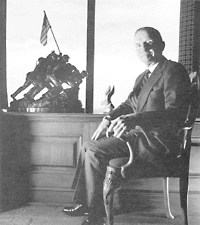 Ross said, "You can take my picture, but I'm just going to sit right here in this chair. That's all I'm gonna do." So what did Brian do? He says, "Okay." He puts the light down on the floor and he does this harsh light on his face and he shoots from a low angle, which to me really accentuates the fact that he's this little short Napoleon. There's a situation where the CEO didn't cooperate at all, and that forces the photographers to come up with ways to take interesting pictures, and because they do that sometimes they're unflattering.
Ross said, "You can take my picture, but I'm just going to sit right here in this chair. That's all I'm gonna do." So what did Brian do? He says, "Okay." He puts the light down on the floor and he does this harsh light on his face and he shoots from a low angle, which to me really accentuates the fact that he's this little short Napoleon. There's a situation where the CEO didn't cooperate at all, and that forces the photographers to come up with ways to take interesting pictures, and because they do that sometimes they're unflattering.
Former President George Bush and Millie, by Keith Carter, Houston, February 1994
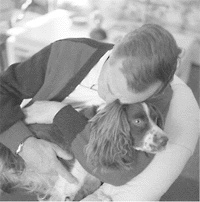 What I really love about this photograph is that it was taken right after he left office and what you'd seen for four years was pictures of him very stiff and very posed and very presidential, where I'm sure he'd had all sorts of handlers and managers and PR people telling him how he should have his picture taken and giving him advice. Here he was all of a sudden he's gone back to Houston, definitely caught in a posed situation because he obviously knew he was being photographed but what Keith captured was this true emotion just hugging the dog, you see his little bald spot, he has his little Mr. Rogers sweater on, and to me it was just an unguarded moment of truth, and that's what I like about posed pictures, when those true emotions come through.
What I really love about this photograph is that it was taken right after he left office and what you'd seen for four years was pictures of him very stiff and very posed and very presidential, where I'm sure he'd had all sorts of handlers and managers and PR people telling him how he should have his picture taken and giving him advice. Here he was all of a sudden he's gone back to Houston, definitely caught in a posed situation because he obviously knew he was being photographed but what Keith captured was this true emotion just hugging the dog, you see his little bald spot, he has his little Mr. Rogers sweater on, and to me it was just an unguarded moment of truth, and that's what I like about posed pictures, when those true emotions come through.






